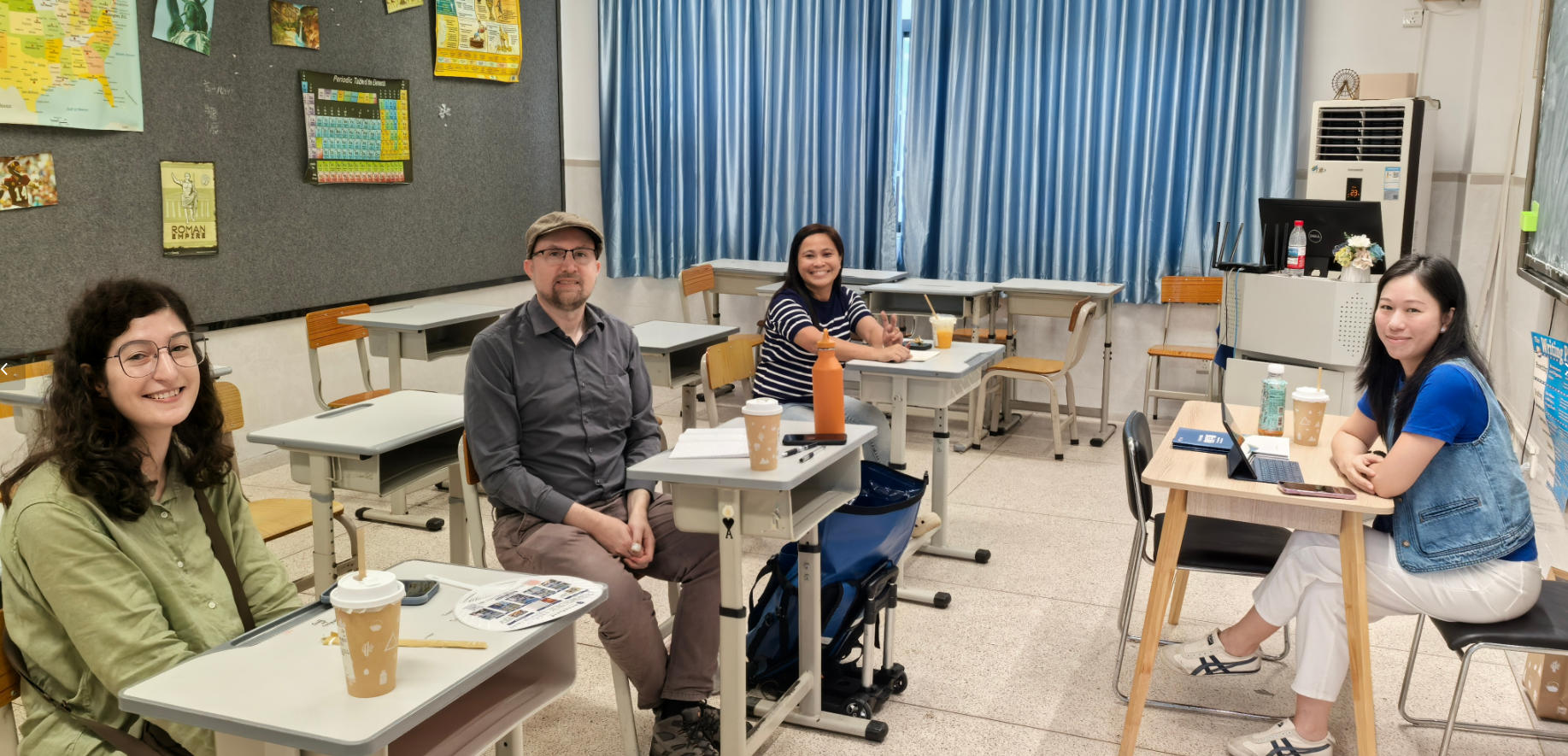Five Steps to Adapting High School Teaching to Middle School Students
Samantha Butler, a Social Studies and English teacher at the KL International School (KLIS) in Chongqing, shares the challenges and rewards she has experienced teaching middle school.
Education seems to be an ingrained forced within me. When I was in elementary school, if I ever found out anything new or exciting, I would gather a group of avid followers and tell them this information. This continued into high school when I took over Advanced Placement (AP) test prep courses and created my own curriculum to train my classmates and myself.
I have always wanted to educate, which is why when I found myself being offered a position to teach middle school instead of the position for high school I applied for, I didn’t hesitate. I jumped in, feet first. Sure, I had middle school experience, but honestly, I love teaching high school and I was good at it.
However, when I got to the KnowledgeLink International School, I found myself a bit floundering in the curriculum and I was playing catch-up coming so late into the school year. Also, after initial assessments, students were at so many different levels in the English language, and those levels were so much lower than what I was used to because I was used to high school ESL and high school temperaments and personalities.
Middle school kids are at a unique crossroads. They are above elementary kids, but they want to play just like 3rd graders. They are expected to be leaders, but they rough house too much or have not learned to hold their tongues when replying back to an adult with whom they disagree. They question everything, but won’t sit still long enough to get those questions answered. They want to do homework, but they just want to play, so they are in a constant battle with themselves to do good or wait until tomorrow…Or at least my middle schoolers are this way.
So, with all the emotions, energy, and clap back, adapting to teaching these kiddos has been somewhat of a challenge. Nevertheless, I have come up with a simple system to adapting my teaching ways to even the most struggling student.
Step 1: Assessments Work
Data collecting has become ingrained the United States education system and a bunch of it is hokum, in my opinion. The use of that data is so superficial or not explained well, that people get lost in the testing. However, if you find a system that works for you, then assess. Students need to see their progress as much as you do and if you show them via an assessment how far they have come, they will work harder to go farther. For example, I have a student that was for sure a solid 2nd grade level in my class in all four areas of English development (reading, writing, listening and speaking). This was especially true for his speaking level. I record videos of student presentations and I showed him a video of how far he had come in his speaking from the first time he presented in my class. Now, his hand is the first to go up when answering a question in class and he is not afraid to make mistakes because he knows he is getting better.
Also, knowing the grade level of your kids is good for adapting your instruction to their personal needs. I can tell from gathering a reading and writing sample and from a couple of weeks of presentations and listening activities what level my kids are at, but a solid assessment system will give you solid information.
Step 2: Personality Inventories
Try to figure out what makes your kids tick. Middle school kids are different from high school kids in the way that they are discovering their emotions and feelings and putting names and reactions to everything. Yes, high school kids are doing this, too, but they may have the language or the couth to hold back from the swelling amount of hormones running through their bodies. Whereas middle school kids have no chill. They don’t know how to hold back anything, so you have to see what makes them tick.
I work at an international school with primarily Korean and Chinese first-language students. When you are learning English, your fall back to do work and what not is still your first language. So you use your first language to communicate anything you cannot fully realize in English.
I have a student who is curious and questions everything, but his own actions and words. He gets mad when the students that are not from his country speak their first language because he thinks they may be talking about him. Yet, when he is talking about students, he yells under his breath at them in his first language. Why does he do this? He isn’t being malicious or petty. He doesn’t understand the full circle of his actions in relation to the actions of others. This is something I am trying to teach him: you cannot expect others to behave in a way that you are unwilling to behave in yourself. So, I taught him the word hypocrite. Now, it has become a moniker for the entire class (because it’s middle school) and they will call one another hypocrites whenever someone is speaking in their first language, no matter the situation; but last week he used the word correctly during his free write in which he was assessing the prowess of his country’s political powers.
I “get” my students. I know what it takes to make them tick. For the student above, calling him out in front of his classmates is a no go, but for others it is exactly how you get their attention. For some, one-on-one instruction or giving a piece of fruit or just playing basketball with them all outside, is all they need to want to learn in your class.
Step 3: Research
As a teacher, I cannot do anything alone. I have an exceptional team that I work with in all our content areas. For all the years of teaching experience I have, I cannot do anything on my own. I research the crap out of any and everything that I do in order to see if it will be conducive to my students’ needs.
So, I have been reading books about what it is like to be a middle school student and a middle school teacher. Currently, I am reading “Middle School Readers: Helping Them Read Widely, Helping Them Read Well” by Nancy Allison. It is a book about reading literature and finding literature that supports the needs and interests of your students. I have also been brushing up on “Judy Moody”, by Megan MacDonald, and “Diary of a Wimpy Kid”, by Jeff Kinney. These help me with the personalities and thought processes of middle school aged kids.
Also, I researched the history of Korea and China relations, English language adaption for Chinese students, and I have been learning to read and write in Chinese because I have to correlate the language learning with the language of my students to full see why they can’t grasp an issue. The more research I do, the more I adapt my teaching practices.
For example, I have a student who needs phonics lessons to learn to sound out words at higher levels. Their first language is Chinese and after learning pinyin, I found the sounds for the English alphabet for him to practice at the local grocery store and will be starting this practice with him next week. Being in China, means going beyond academics for research. It means figuring our language, history, and culture.
Step 4: Curriculum Organization
If your lessons are not planned well, middle school students smell blood and immediately run away from whatever you were trying. For high school students, you can come in with a few free writes and spend the day writing. Middle school students have an attention span that runs in 5 minute increments. Five minutes of lecture. Five minutes of copying notes. Five minutes of practice. Five minutes of talking. Five minutes of activity. Five minutes of running around. Five minutes to pack up to the next class.
You cannot “wing” middle school curriculum. You have to plan everything out. I recommend using curriculum maps or graphic organizers to plan out your daily lessons. I haven’t had to do daily lessons for years. I do weekly lessons or unit plans.
Not this year., though. I do daily lessons because each day they need purpose that is new. Even if you didn’t finish yesterday’s purpose, they need a new purpose. Instead, I do daily lessons that all tie into one theme (of course, after spending three weeks on teaching theme and what theme meant and how to find theme in books, etc.). Now, my kids come in on Monday wondering what the theme of the week is. Last week in Social Studies, it was “Cultural Awareness”. Next week it will be “Cultural Studies”. We work on word breakdowns, vocabulary banks, sentence structures, historical context, data and research, group projects, individual projects, etc. It all ties in together.
Also, if you are like me and like projects, all projects need massive amounts of organization in order to be executed. You need the backwards planning rubric for yourself and mapping initial expectations, but you also need rubrics and calendars for them to organize themselves, updates on grades/assignments, etc. I have a ton of resources for these types of things as well that I have been slowly moving to my One Drive for future pulling.
Step 5: Mistakes are Okay
If you tell your students that it is okay to make mistakes and you show them your mistakes, apologizing for them, they will begin to take chances. In middle school, students are scared of the social ramifications of making mistakes in front of their peers. Students in middle school have no hold back, so if you make a mistake, then you are chided for it. No matter how many bully prevention meetings you have, they are still cruelest in middle school.
So, be the example. I make mistakes on purpose and reward students who find them. But I remind them that mistakes are a part of life and even when you make an emotional mistake, you cannot dwell on it or the fall back from others. You have to move forward and keep teaching. Am I a bad teacher for making that mistake? No; and neither are you. Mistakes help us learn.
Want to join our inspiring community of educators teaching on our global campuses? Check out our KL career opportunities today!








关于我们
了解更多
总部地址
101 Federal Street, Suite 1900,
Boston, MA 02110
1-781-996-0425
info@kleducation.org
订阅我们